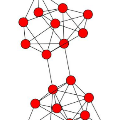Many resource allocation problems in the cloud can be described as a basic Virtual Network Embedding Problem (VNEP): finding mappings of request graphs (describing the workloads) onto a substrate graph (describing the physical infrastructure). In the offline setting, the two natural objectives are profit maximization, i.e., embedding a maximal number of request graphs subject to the resource constraints, and cost minimization, i.e., embedding all requests at minimal overall cost. The VNEP can be seen as a generalization of classic routing and call admission problems, in which requests are arbitrary graphs whose communication endpoints are not fixed. Due to its applications, the problem has been studied intensively in the networking community. However, the underlying algorithmic problem is hardly understood. This paper presents the first fixed-parameter tractable approximation algorithms for the VNEP. Our algorithms are based on randomized rounding. Due to the flexible mapping options and the arbitrary request graph topologies, we show that a novel linear program formulation is required. Only using this novel formulation the computation of convex combinations of valid mappings is enabled, as the formulation needs to account for the structure of the request graphs. Accordingly, to capture the structure of request graphs, we introduce the graph-theoretic notion of extraction orders and extraction width and show that our algorithms have exponential runtime in the request graphs' maximal width. Hence, for request graphs of fixed extraction width, we obtain the first polynomial-time approximations. Studying the new notion of extraction orders we show that (i) computing extraction orders of minimal width is NP-hard and (ii) that computing decomposable LP solutions is in general NP-hard, even when restricting request graphs to planar ones.
翻译:云层中的许多资源分配问题可以被描述为一个基本的虚拟网络嵌入问题(VNEP):在底盘图(描述物理基础设施)上找到请求图(描述工作量)映射图(描述物理基础设施)。在离线设置中,两个自然目标是利润最大化,即:嵌入受资源限制制约的要求图的最大数量,以及成本最小化,即以最低总成本嵌入所有请求。VNEP可以被看成是典型路程和接收问题的概括化,其中请求是任意的图表,其通信端点没有固定的。由于应用程序的应用,问题已经在网络界中深入研究。然而,基本的算法问题是利润最大化。本文为 VNEEP提供了第一个固定参数的可拉动近的算法。我们的算法以随机四舍为根据。由于灵活的映射选项和任意请求的图表型结构,我们展示了一个新的直线性程序配置。只有使用这种新式的公式, 才能计算直径直线式的直径直径的直径直方图组合, 也就是计算直径直径的直径直径直径直径直的直径的直径直径直径直径,, 。由于其直径直图的直径直图的直图的直径直图的计算, 我们的直径直的直的直直的直的直的直的直直径直的直的直的直的直的直径直径直径直径直径直图的计算,,,,我们方的直径直径直到的直到的直的直的直线的直到的直径直径直至直到的直的直到的直到的直的直的直的直的直的直的直到我们的直的直的直的直到的直的直到的直的直的直到直的直的直的直到的直的直的直到的直的直到的直到的直到的直径直径直径直径直径直至直至直到的直到的直到的直到直到直到的直到的直到直径直径直径直径直径直径直径直径直径直径直径直径直径直至直到的直到的直到的直到




